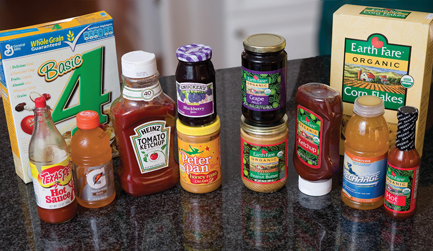Revealing the good, bad and ugly ingredients lurking in your food
Think you’re eating healthy? Your pantry may give you away.
Barry and D.J. Mitsch, of Cary, believed they were managing their family’s dietary habits well, until Maria DiLalla, of organic supermarket Earth Fare, conducted a pantry makeover at their home.
Out went the Texas Pete, Peter Pan, Smucker’s, Gatorade and Heinz, all replaced with healthier alternatives.
“We try to eat healthy, but the truth is when you’re working and traveling, that’s not always the case,” D.J. said. “It’s what you have on hand to cook that makes the difference.”
The Mitsches, who own a corporate coaching firm, have a son Hank, 17, an athletic “carnivore,” his mom jokes, and a daughter Jessica, a vegetarian and dancer away at college.
“I go to the farmers market almost every Sunday,” D.J. said. “We eat fresh fruit and lots of grilled veggies. We all eat breakfast, and we don’t drink soda … but we do eat out a lot.”
“It’s all in the choices you make,” agreed Barry, who began reading nutrition labels several years ago, when his doctor recommended a low-cholesterol diet.
A health-conscious effort is evident in the family pantry, home to whole-grain pasta, couscous, quinoa and stock for vegetable soup.

Their goals for the makeover include “some healthy snacks for Hank, and some better breakfast alternatives. Things that are handy, easy, quick and nutritious,” D.J. said.
Enter DiLalla, community relations coordinator for Earth Fare, which offers free pantry makeovers to those who sign up for My Health Journey at www.earthfare.com. DiLalla says many common pantry items contain ingredients that make them less than family-friendly. Ingredients such as hydrogenated oils, high-fructose corn syrup and artificial colorings, flavorings and preservatives are linked to health issues and are banned from Earth Fare stores as part of its strict eight-step food philosophy.
The point, DiLalla says, is choosing natural ingredients over artificial.
“You can still have cookies and sugar; it’s a matter of where the food comes from,” she said.
Earth Fare defines organic products as those grown without pesticides, chemicals or harmful fertilizers.
“And natural means that it’s not super-processed,” DiLalla said. “You don’t have to artificially produce items for them to taste good.”
After checking labels against Earth Fare’s “boot list,” all but one of the Mitsches’ salad dressings get the green light to stay — but Peter Pan is out. Full of hydrogenated oils, DiLalla replaces the peanut butter with an organic version containing similar fat content, but far less sodium and sugar. She notes that without chemical preservatives, products such as this may have shorter shelf lives and require refrigeration.

The Mitsches’ mustard and Classico marinara are keepers. Cheerios and Clif power bars pass inspection too, to Barry’s relief, but his favorite Basic 4 cereal is rejected for its artificial flavorings. DiLalla instead offers organic raisin bran, cornflakes, shredded wheat and “Cocoa Bites.”
“People can be comfortable with new choices,” she said. “They look similar, and they taste just as good.”
Natural food choices are becoming more widely available in grocery stores, says Maria Tucker, registered dietician and certified diabetes educator at Duke Raleigh Hospital. They’re a good step to avoiding unhealthy ingredients.
Hydrogenated oils, for example, contain trans fatty acids not processed naturally in the body, which can increase the risk of heart attack and stroke. High fructose corn syrup, found in sodas and juice drinks, is cheaper to produce than sugar, Tucker says, but increases calorie intake, leading to weight gain or obesity.
The recommended limit of added sugar is 6 teaspoons a day (or 100 calories) for women and 9 teaspoons for men, Tucker says. And artificial food colorings have been linked to ADHD in studies, and to certain cancers.
“That’s why there’s the push to ban them from the market, and out of our food sources,” Tucker said. “Europe and the U.K. have already banned their use, and are using more natural food colorings,” such as vegetable and fruit dyes.
 Make sure, she says, that hydrogenated or partially hydrogenated oils, high fructose corn syrup and other artificial ingredients are not listed among a product’s first three to five ingredients.
Make sure, she says, that hydrogenated or partially hydrogenated oils, high fructose corn syrup and other artificial ingredients are not listed among a product’s first three to five ingredients.
Also, understand labels: “0 trans fat” usually means per serving, not per package. Individual food servings should contain less than 5 grams of fat, with 2 grams or less saturated fat.
And reduced fat or reduced sodium labels serve only as comparisons to the original product.
“It must say low sodium, low fat or low sugar, not just ‘reduced,’” Tucker said. “Be careful.”
She recommends tub margarine over stick for less fat, fruit served atop plain cereals for less sugar, an egg a day for protein, and whole grain rice and breads.
“Be more adventurous,” she said. “Try couscous or quinoa as a substitute for white rice and instant mashed potatoes.”
Barry is delighted to find Pirate’s Booty — a snack of white cheddar rice and corn puffs — in DiLalla’s “go” basket. He’s less excited about her next pantry news. Texas Pete hot sauce contains preservative benzoate of soda. Gatorade includes artificial colors, the preserves have artificial preservatives and the ketchup has high-fructose corn syrup.
“I’m persnickety about my ketchup, so the Heinz will be hardest for me to give up,” Barry said. “And how about that — my Smucker’s has high-fructose corn syrup. I didn’t look closely enough at those labels. And the Gatorade — we bring cases of that every weekend for the kids to consume at sports.”
Eating healthy doesn’t have to mean doing without taste or money: Earth Fare stores carry their own and other brands of popular items including toaster pastries, cookies and Coca-Cola made in Mexico with cane sugar instead of high-fructose corn syrup, and DiLalla says prices are competitive with major grocery chains.
“It’s your food; invest in it,” she said.
For the Mitsch family, the pantry point has been made.
“We’re definitely on the right track,” Barry said. “It’s good to know that some of the things we eat a lot of are good for us. This helps us fine-tune it.”
For more information on eating healthy, visit www.USDA.gov for information on labeling and www.eatright.org, from the American Dietetic Association.






